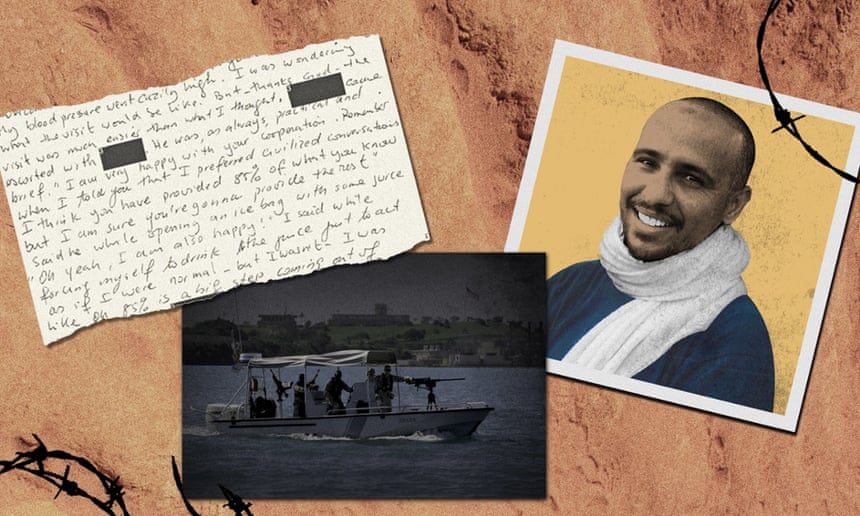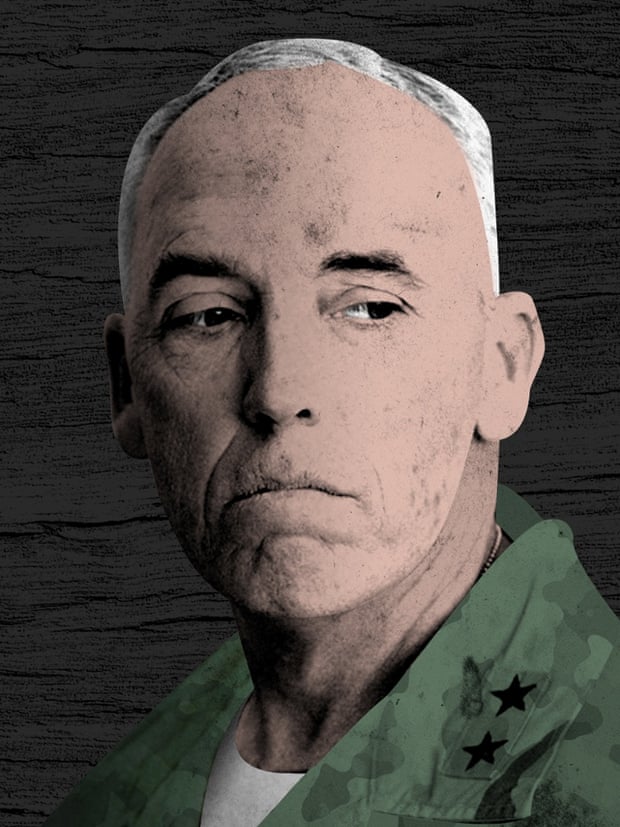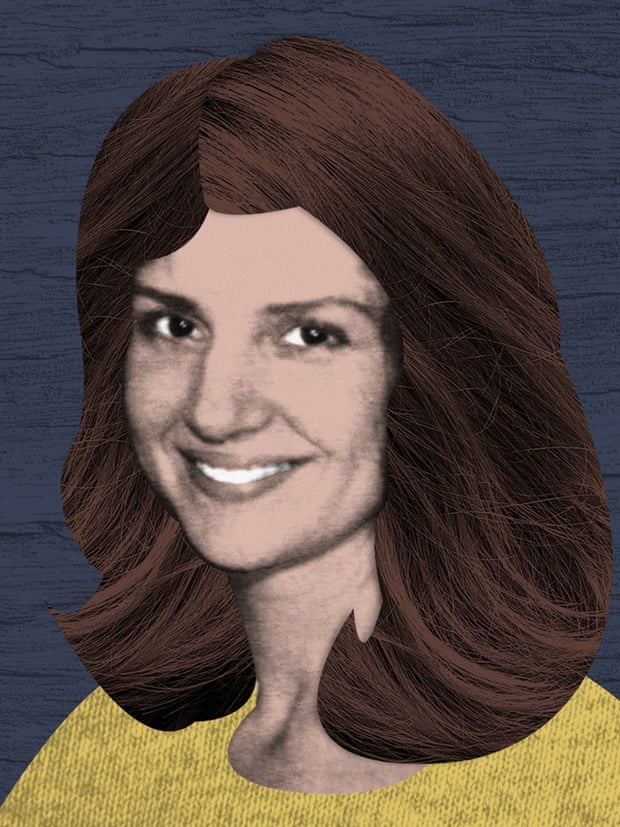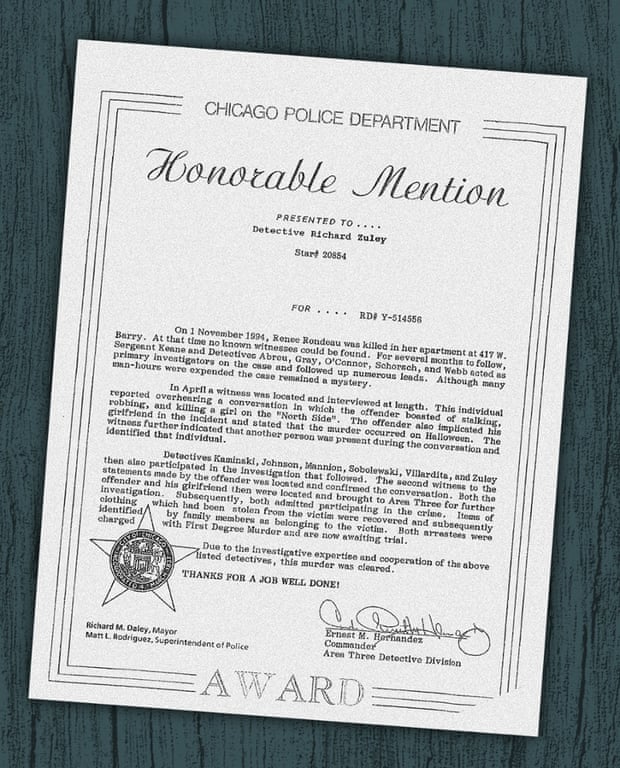American Police Brutality, Exported from Chicago to Guantánamo
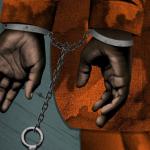
When the Chicago detective Richard Zuley arrived at Guantánamo Bay late in 2002, US military commanders touted him as the hero they had been looking for.
Here was a Navy reserve lieutenant who had spent the last 25 years as a distinguished detective on the mean streets of Chicago, closing case after case – often due to his knack for getting confessions.
But while Zuley’s brutal interrogation techniques – prolonged shackling, family threats, demands on suspects to implicate themselves and others – would get supercharged at Guantánamo for the war on terrorism, a Guardian investigation has uncovered that Zuley used similar tactics for years, behind closed police-station doors, on Chicago’s poor and non-white citizens. Multiple people in prison in Illinois insist they have been wrongly convicted on the basis of coerced confessions extracted by Zuley and his colleagues.
The Guardian examined thousands of court documents from Chicago and interviewed two dozen people with experience at Guantánamo and in the Chicago criminal-justice system. The results of its investigation suggests a continuum between Guantánamo interrogation rooms and Chicago police precincts. Zuley’s detective work, particularly when visited on Chicago’s minority communities, contains a dark foreshadowing of the United States’ post-9/11 descent into torture.
Allegations stemming from interviews and court documents, concerning five Chicago suspects, suggest Zuley and his colleagues shackled suspects to walls for extended periods, threatened their family members, and perhaps even planted evidence on them. The point was to yield confessions, even while ignoring potentially exculpatory evidence.
Several of those techniques bear similarities to those used by Zuley when he took over the interrogation of Mohamedou Ould Slahi at Guantánamo, described in official government reports and a best-selling memoir serialised last month by the Guardian as one of the most brutal ever conducted at the US wartime prison.
A woman still in an Illinois prison who insists on her innocence, Benita Johnson, recalled Zuley and his team handcuffing her to a wall for over 24 hours in 1995 until she would implicate herself and her ex-boyfriend in a murder, while Zuley threatened her with never seeing her children again. One of many awards in Zuley’s record file – bearing the name of Chicago mayor Richard Daley – praises his help in interrogating the two suspects who ultimately “admitted participating in the crime”.
Nearly a decade later, Zuley – whose interrogation plan for Slahi received personal sign-off from then-defense secretary Donald Rumsfeld but has gone almost entirely unreported – would tell the detainee that the US had his mother in custody, US government investigations have documented, even while they avoid Zuley’s name. If Slahi didn’t start talking, Zuley said he would have her brought into Guantánamo’s all-male prison environment, which his lawyers consider a rape threat. Slahi began confessing to anything he could.
Though prosecutors refused to bring charges once they learned what Zuley and his team had done, Slahi – like the Illinois woman Zuley interrogated that night, and others back on the mainland – remains behind bars.
“I’ve never seen anyone stoop to those levels,” Stuart Couch, a former Marine lieutenant colonel and military commissions prosecutor, said of Zuley’s interrogation of Slahi. “It’s unconscionable, from a perspective of a criminal prosecution – or an interrogation, for that matter.”
Mark Fallon, deputy commander of the now-shuttered Criminal Investigative Task Force at Guantánamo, said Zuley’s interrogation of Slahi “was illegal, it was immoral, it was ineffective and it was unconstitutional.” It is unknown if Zuley interrogated other Guantánamo detainees.
Through a spokeswoman at his current job, with the Chicago department of aviation, Zuley declined participation with this story, despite repeated attempts. Chicago police have yet to fulfill a freedom-of-information request on Zuley’s personnel file, and detailed lists of questions sent Tuesday from the Guardian to Zuley’s attorney and a Chicago police department spokesperson went unresponded.
Now, a reckoning with Zuley’s past may be coming. An innocent man, Latherial Boyd, has filed a federal civil-rights lawsuit against him after spending half his life in prison. On Tuesday, papers filed in federal court showed that the conviction-integrity unit of the Cook County state’s attorney is interested in examining civilian complaints against Zuley related to another wrongful-conviction case.
“When I learned that Zuley was head of a special projects team at Guantánamo,” said Kathleen Zellner, the lawyer leading the civil-rights case, “my first reaction was: ‘Really? I would love to see the selection criteria for that job.’”
From a blindfolded boat ride to threats against his family members and hours shackled to Gitmo floors, Zuley’s interrogation of Mohamedou Ould Slahi shocked investigators. To make it stop, Slahi says he signed on to whatever his captors wanted him to voice. Illustration: Nate Kitch for the Guardian
The detective, the general and the boat ride: shackling and threats at the Bay
Even as he investigated crime in Chicago, Zuley’s Navy reserve service kept him on the military’s radar. When called up to active duty, Zuley, by his own telling, deployed for some attention-grabbing missions. He told a Chicago court in a mid-1990s murder case that he “took assignments with Naval intelligence” for four years after getting shot on the job in 1982: “I did counter terrorists work for them.”
A detective colleague, Ray Kaminski, testified in a 1997 murder trial that he understood Zuley was “somewhere in South America … working with the US Navy”.
In April 2004, while serving in a senior position at Guantánamo, Zuley returned to Chicago to testify at an evidentiary hearing. The court transcript, acquired by the Guardian, records Zuley saying he “was mobilized for the war on terror in November of 2002.” Initially assigned to a Royal Air Force base in Molesworth, his superiors “sent me to Cuba as the liaison officer for the European Command. And that job has evolved to what I’m doing now” – that is, “assigned to the Joint Task Force Guantanamo as an officer in charge of one of the teams down there for the intelligence collection.”
While Zuley’s role helming Slahi’s interrogation has featured in official investigations by the Justice Department, the Defense Department and the US Senate, he is rarely referred to in those documents by name. A 2013 book by Wall Street Journal reporter Jess Bravin is a rare account that identifies him, as is a November blogpost by Firedoglake’s Jeff Kaye. But Zuley does appear by name in footnotes of the Senate armed services committee’s 2008 investigation into military torture, and in footnotes in Slahi’s recent best-selling memoir. (Less officially, Zuley has also referred to himself as a senior Guantánamo interrogator and special-projects team chief in an Amazon.com book review.)
Several Guantánamo Bay veterans, four of whom remembered Zuley, said that the hasty establishment of the detention center in January 2002 severely taxed the military’s resources. An interrogation corps needed to be built from scratch in the wake of 9/11. Fallon, the former deputy commander of the Guantánamo investigative task force, explained that the Gitmo leadership was “searching for a hero,” since its interrogations weren’t getting the desired results.
The first wave of military interrogators was overwhelmed. There were only 26 of them, supplemented by a handful of FBI and intelligence agents, to interrogate 300 initial detainees – mostly Saudis, Afghans, Pakistanis and Yemenis. Only four of the military interrogators spoke Arabic. Two spoke Farsi.
The Defense Department asked a renowned retired Army colonel, Stuart Herrington, to visit Guantánamo and advise the interrogations command. When he arrived in March 2002, Herrington despaired to see that military and civilian interrogators had no idea who their new charges were, reversing the desired dynamic of the “omniscient” interrogator.
“Of the 300, they were sure they had the correct identification, name and biometric data of about 30% of them,” Herrington told the Guardian. “If you don’t know who you have, that pulls the props right from under the interrogation.”
Guantanamo was not optimized for gathering intelligence. Herrington bristled to see orange-jumpsuited detainees carried to wooden shacks by guards and shackled to the floor – techniques that reinforced the detainees’ anger at their confinement, undercutting the rapports Herrington advised would be critical for getting them to talk.
Guantánamo veterans said Zuley influenced and cultivated the patronage of Major General Geoffrey Miller, who later recommended that he wanted to ‘Gitmo-ize’ Abu Ghraib. Illustration: Nate Kitch for the Guardian
Into that dynamic stepped Zuley. Fallon remembered Zuley making an immediate impression on Major General Geoffrey Miller, who assumed command of Joint Task Force-Guantanamo in November 2002. Zuley had a reputation as “a big self-promoter,” Couch, the military prosecutor, recalled as well.
“From what I was told, General Miller thought he was the greatest thing since sliced bread,” Couch said. “Miller was amazed at the information he was getting. So apparently Zuley ratcheted up these techniques, with the backing of Miller, to go up the chain of command for approval.”
Miller retired from the Army in 2006. He has disappeared from public view after invoking his right against self-incrimination when called as a witness in an Abu Ghraib-related trial that year. Emails seeking comment about Miller’s relationship with Zuley bounced back, and a spokesperson for the US Southern Command, which oversees Guantánamo, did not know how else to contact him.
Mohamedou Ould Slahi was seen as a huge priority for Guantánamo upon his August 2002 arrival. US officials suspected Slahi, a veteran of the anti-Soviet jihad in Afghanistan, as a critical link to al-Qaida’s recruitment of the 9/11 hijackers in Europe.
As the military intensified its treatment of Slahi, the FBI and Fallon’s task force, uncomfortable with torture, pushed back. But the military took full control of Slahi’s interrogation. On July 1, 2003, Miller approved a “special projects status” request for Slahi from the Defense Intelligence Agency, with Zuley placed in charge. By August 13 of that year, Rumsfeld personally signed off on the Slahi interrogation, already under way.
In addition to using stress positions, sleep deprivation and auditory bombardment against him, Zuley intended to make Slahi think he was taken somewhere else, somewhere more dangerous for him. He would be placed on a boat, and taken around the bay to disorient him, though they would never actually leave Guantánamo. Dogs would be used during the transport, Zuley wrote in a memo uncovered by a Senate committee, to “assist developing the atmosphere that something major is happening and add to the tension level of the detainee.”
The boat trip came at night, with Slahi blindfolded, and lasted three to four hours. American guards were there, kicking him, and apparently cycled back to the coast after around 40 minutes, where an Egyptian and a Jordanian interrogator took over. They placed Slahi in “a kind of thick jacket” that inhibited his breathing, he wrote in his memoir, and already had a bag over his head. They stuffed the jacket full of ice and repeatedly punched him.
Slahi recalled: “I was hurt like never before; it wasn’t me any more, and I would never be the same as before.” He also remembered a voice he associated with Zuley telling the foreigners: “We appreciate everybody who works with us, thanks, gentlemen.”
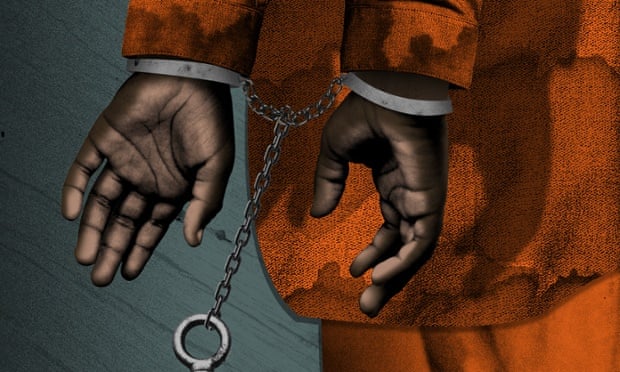 Eyebolts, meant to prevent suspects from harming themselves or their interrogators, can also be used for shackling a detainee’s hands. Three people Zuley sent to jail told the Guardian and allege in court documents that he shackled them for hours to eyebolts in the wall of a precinct. Illustration: Nate Kitch for the Guardian
Eyebolts, meant to prevent suspects from harming themselves or their interrogators, can also be used for shackling a detainee’s hands. Three people Zuley sent to jail told the Guardian and allege in court documents that he shackled them for hours to eyebolts in the wall of a precinct. Illustration: Nate Kitch for the Guardian
Slahi’s new cell was to be structured to prevent light from shining in. He was shackled to an eyebolt – a latch to secure prisoners’ cuffs or chains, like those found in many police precinct houses, but lower to the ground – and left alone for hours with music blasting. He was permitted four hours sleep every 16 hours. Masked interrogators told him they had dreams about murdering him.
Sometimes they soaked him with ice-cold water in what Slahi called “the freezing room”. Other times they turned off the air conditioning and Slahi would have to stand, handcuffed, for hours on end. It was an extreme version of a technique Zuley used in Chicago: three people he sent to jail told the Guardian and allege in court documents that Zuley shackled them for hours to eyebolts in the wall of the precinct house at Belmont and Western avenues on Chicago’s north side.
Eyebolts, a feature in US police stations before Guantanamo, are not Zuley’s invention. Used responsibly, they prevent suspects from harming themselves or their interrogators. But law-enforcement veterans say their use in restraining detainees for hours and their use in interrogations is problematic.
“I can’t imagine any legitimate purpose for using eyebolts during an interrogation other than the necessary, temporary physical restraint of the detainee,” said Michael German, a former FBI agent.
Chicago inmates also remembered Zuley’s deception – which he also ratcheted up at Guantánamo.
There, government investigations have confirmed, Zuley pretended to be a White House aide and senior Navy officer called “Captain Collins”. He produced a concocted document saying Slahi attempted to blow up Los Angeles airport and recruited three of the 9/11 hijackers. It went on to say that the government would punish Slahi’s uncooperativeness by arresting his mother, possibly taking her to Guantánamo, and referring to, as a Justice Department inquiry later stated, “the administrative and logistical difficulties her presence would present in this previously all-male prison environment.”
“Is that not harsh and unfair?” Slahi responded, according to his memoir.
“I am not here to maintain justice,” Zuley replied. “I’m here to stop people from crashing planes into buildings in my country … You have two options: either being a defendant or a witness.”
The techniques – prolonged shackling, family threats, demands to implicate others – eventually broke Slahi. He began confessing falsely to whatever he thought his interrogators wanted him to sign. “I don’t care, as long as you are pleased. So if you want to buy, I am selling,” he said.
Couch, who was trying to charge Slahi with terrorism-related offenses, initially viewed Slahi’s sudden talkativeness as a blessing. But as he investigated further, he found that he couldn’t bring any prosecution at all – that the interrogation led by Zuley had tainted too much. If Slahi truly was dangerous, confessions beaten and threatened out of him were inadmissible in court, and a judge might throw the whole case out. If Slahi wasn’t, Richard Zuley, on behalf of the United States, had tortured an innocent man.
Couch was especially taken by accounts from psychologists describing Slahi hallucinating from the abuse. Now a judge in Charlotte, North Carolina, Couch to this day considers what Zuley did to Slahi extremely serious.
“Cruel treatment like Slahi experienced meets the definition of cruel inhumane and degrading treatment or punishment – they call it CID for short – a grave breach under common article three of the Geneva Conventions,” Couch said, “and therefore a violation of the law of armed conflict.”
“I can understand Zuley’s motivation to get information out of Slahi, but he had to do it in a way that was legal and credible,” Couch continued. “He didn’t do either, and our nation has paid the price.”
As Zuley’s interrogation of Slahi was underway, Miller, the Army two-star general in charge of the Guantánamo detention center, traveled to Iraq at the behest of the Pentagon. He recommended that the US military “Gitmo-ize” Abu Ghraib, intensifying interrogations there. It is unknown if Zuley or the Slahi interrogation influenced that recommendation. The result is clearer: Antonio Taguba, the Army general who blew the whistle on Abu Ghraib, cited Miller’s influence as a driver of what would become the US military’s worst wartime scandal since My Lai.
To this day, Slahi remains at Guantánamo, uncharged, living in a separate facility where he is allowed to garden and watch TV. A federal judge ordered him free in 2010, but Barack Obama’s Justice Department has appealed; the case is stalled. It is unclear when, if ever, Slahi will be set free.
Fallon, the former Guantánamo investigative task force deputy commander, remembered Miller and other “two-stars that wanted three stars” attempting to placate Fallon’s dissatisfied, skeptical investigators by holding up Zuley as their very own law-enforcement veteran.
“When Zuley came down, they were able to tout him as ‘Hell yeah, he’s just like you guys, he’s a detective’ and this and that,” Fallon said.
“I never met him before. There’s good detectives and there’s bad detectives, there’s good interrogators and there’s bad interrogators.”
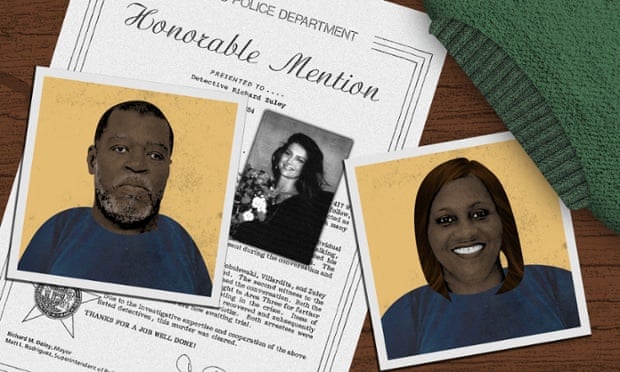
When Andre Griggs (left) got fingered by a snitch for the high-profile murder of Renee Rondeau (middle), he says Zuley and his colleagues coerced him into signing a false confession – following hours of shackling and withdrawal at a Chicago police precinct. His ex-girlfriend, Benita Johnson (right), says she was threatened into implicating him, too. ‘Basically,’ she told the Guardian from prison, ‘they just tortured me.’ Illustration: Nate Kitch for the Guardian
The addict, the ex-girlfriend and the turtleneck: shackling and threats at the precinct
Benita Johnson said she spent more than 24 hours with her hand chained to the wall through a metal eyebolt, starting in the pre-dawn hours of April 15, 1995, listening to Zuley tell her she had a fateful choice to make. Already jailed on a drug charge, Johnson could either confess to a murder and implicate her ex-boyfriend in it – or she would never see her children again. She might even face the death penalty. Chained and terrified, she made her choice and lied.
“He did a lot of threatening, hollering in my face, telling me I was gonna lose my kids, I wasn’t going to never get out of prison,” Johnson remembered of Zuley, 20 years later, from Logan correctional center in Lincoln, Illinois. “Just a whole lot of threatening and intimidation.”
It was the second time police had chained her up in as many weeks. According to Johnson, she had already gone through the same ordeal – taken from the Cook County jail to the police station, early, for a long time, and in restraints. Only now the police also wanted to know about her ex-boyfriend, Andre Griggs, a heroin addict and petty criminal.
Zuley, the other officers and assistant state’s attorney John Dillon presented the shackled Johnson with a confession. Johnson, who described herself as “illiterate to the system,” said she didn’t read it. Feeling trapped, emotionally and physically, she signed what was in front of her. (One of the detectives involved, Ray Kaminski, testified that Johnson talked with Dillon, who produced the written statement, after six hours with police – and further testified that he cuffed Johnson to the eyebolt, where she remained for at least that long.)
Johnson said: “I just went through so much, I just did what they told me to.” Griggs is in jail for life, and Johnson for 60 years, with a parole eligibility in 2027.
Between the death-penalty threat, the threat to the family and the hours-long confinement, Johnson and Griggs experienced something like a beta test of what Zuley would inflict on Slahi at Guantánamo.
In the case of Renee Rondeau, Zuley and his colleagues had little evidence. After Johnson says Zuley and his colleagues threatened to take away her children and seek the death penalty, she signed a prepared statement and pictures of Rondeau. ‘They basically told me, if I signed that statement, signed those pictures, they was going to let me go,’ Johnson remembered in an interview from prison. Illustration: Nate Kitch for the Guardian
On a rainy Halloween night in 1994, someone strangled 29-year-old Renee Rondeau to death in her apartment after she returned from an exercise class. The case riveted the city – Rondeau had been a homecoming queen – and became the stuff of tabloids and even a TV recreation.
Johnson, backed by testimony from her family at trial, said she was at home with her mother and three children, disinclined to go out on Halloween. “You see on the news that’s when a lot of people do get hurt and killed,” she said.
There was little physical evidence that Andre Griggs and Benita Johnson had murdered Rondeau. A sweep for prints against a fingerprint database discovered no matches, although Griggs and Johnson had prior arrests. Police and prosecutors gave conflicting accounts at trial about the existence of a videotape from a bank showing someone using Rondeau’s ATM card. Nor did police recover the murder weapon, said to be Griggs’s belt.
The main piece of evidence police had connecting Griggs and Johnson to the murder: a green turtleneck sweater that police claim they recovered from Johnson at her mother’s house. It is less certain whether they actually did. Her mother, Mary Tolliver, recalled to the Guardian that she had “never seen it before”; her daughter Theresa, who was nine years old at the time, said the same.
“It is my belief that they planted that sweater on my momma,” Theresa Johnson told the Guardian.
Detective Ricardo Abreu testified that police never actually tested the sweater for Johnson’s hair.
The major basis for suspecting Griggs and Johnson killed Rondeau was the word of a snitch named Eugene Hawes. On March 28, 1995, Hawes told police that Griggs told him that he and his ex-girlfriend went looking for a white woman to rob that Halloween – “for drug money,” a prosecutor would say at trial – and ultimately ended up strangling her. (Johnson said that, to this day, she cannot understand why she would have stolen a sweater from a murder victim if she was meant to be stealing money for drugs.)
Zuley and colleagues took Andre Griggs to the Belmont and Western police station on April 14, 1995 – after picking him up, ostensibly, on outstanding warrants. Speaking from Stateville correctional center, Griggs remembered Zuley and Abreu interrogating him.
“Once I got down to Belmont and Western, they handcuffed me to the wall,” Griggs said. another detective, Tony Villardita, said at trial that the eyebolt to which Griggs was cuffed was three or four feet above the ground. Eyebolts that remain at Guantánamo, viewed by the Guardian over the years, are often in the floor.
Police also had leverage over Griggs: he was a heroin addict. Estimating that he was cuffed to the wall for “29, maybe 30 hours”, Griggs said detectives Zuley and Abreu let his withdrawal get worse. For good measure, they threatened Griggs with seeking the death penalty if he didn’t confess.
“I don’t think there would ever be a good excuse” for restraining someone to an eyebolt for that long, said German, the ex-FBI agent. “Even leaving handcuffs on someone for 24 hours would do serious damage. It should be used as a temporary restraint.”
It worked. Griggs, who was asking for “methadone, anything that would cease the sickness”, signed a confession that prosecutor Paul Fuentes prepared for him. (Villardita testified that Griggs signed the confession after 29 hours.) Abreu denied it at trial, but Griggs said that he was only given his full rights against self-incrimination after he signed.
“They didn’t never tell me that I was placed under arrest,” Griggs told the Guardian, as he did in court papers from his denied 1997 motion for a new trial. Those papers also state Griggs “did not give a written statement until he was in the station for 29 hours”.
The police went back to Johnson early the next day to ask about Griggs and the murder. “Every time I would tell him I didn’t know what he was talking about, he would tighten my cuffs up, real tight, against the wall,” she said.
Johnson gave in. She signed the confession Zuley and his colleagues prepared, and signed pictures of Renee Rondeau. “They basically told me, if I signed that statement, signed those pictures, they was going to let me go,” she remembered.
The Zuley commendation. Illustration: Nate Kitch for the Guardian
“Basically,” Johnson said, “they just tortured me, mentally, and somewhat physically, with the cuffs, and screamed and hollered. I went through a lot.”
Zuley got an official commendation for the Rondeau case. It is signed by the Area Three Commander, and bears the names of Police Superintendent Matt Rodriguez and Mayor Richard Daley. Thanks to the “investigative expertise” of Zuley and his team, it states, both Griggs and Johnson “admitted participating in the crime”.
“THANKS FOR A JOB WELL DONE!”
The full history of US torture has yet to be told. Much of it remains concealed by official secrecy, like the bulk of the landmark US Senate report on Bush-era CIA abuse, or the stories of the 122 Guantánamo detainees Barack Obama continues to hold at the wartime prison he has vowed without success to close.
Parts of that post-9/11 history contain acts of bravery and conscience. FBI agents at Guantánamo Bay resisted the torture of Slahi and other detainees, as did Fallon and Couch. From their work, and those of other experienced interrogators who attempted to get the US out of the torture business, a broad narrative has emerged in the American discourse about torture: law-enforcement interrogation methods are humane and effective, while military or CIA methods are brutal and futile.
Dick Zuley’s history as a military interrogator at Guantánamo and a police interrogator in Chicago scrambles that narrative. It suggests a continuum between police abuses in urban America and the wartime detention scandals that continue to do persistent damage to the international reputation of the United States.
Chicago, in particular, has its own deep and infamous history with police torture, with black Chicagoans its primary victims.
The city’s police violence “was institutionalized,” said Tracy Siska, the executive director of the Chicago Justice Project – and continues, in different forms, to this day.
“Today’s interrogation rooms … the techniques are more sophisticated,” Siska told the Guardian. “It’s around sleep deprivation, around food deprivation, isolation, what you’d consider touchless torture, which is more effective and doesn’t leave any marks.”
• Part two: How Chicago police condemned the innocent – a trail of coerced confessions

